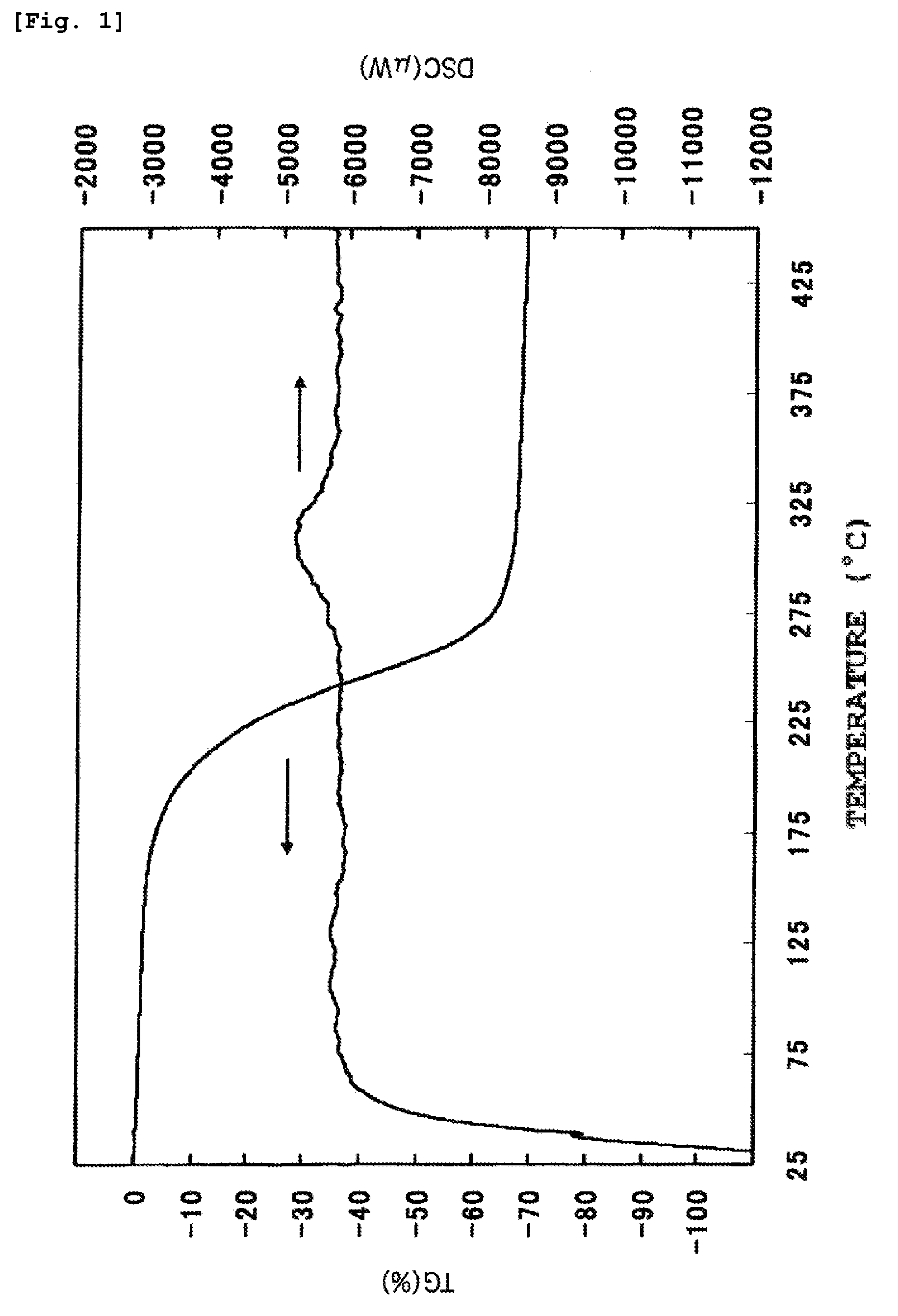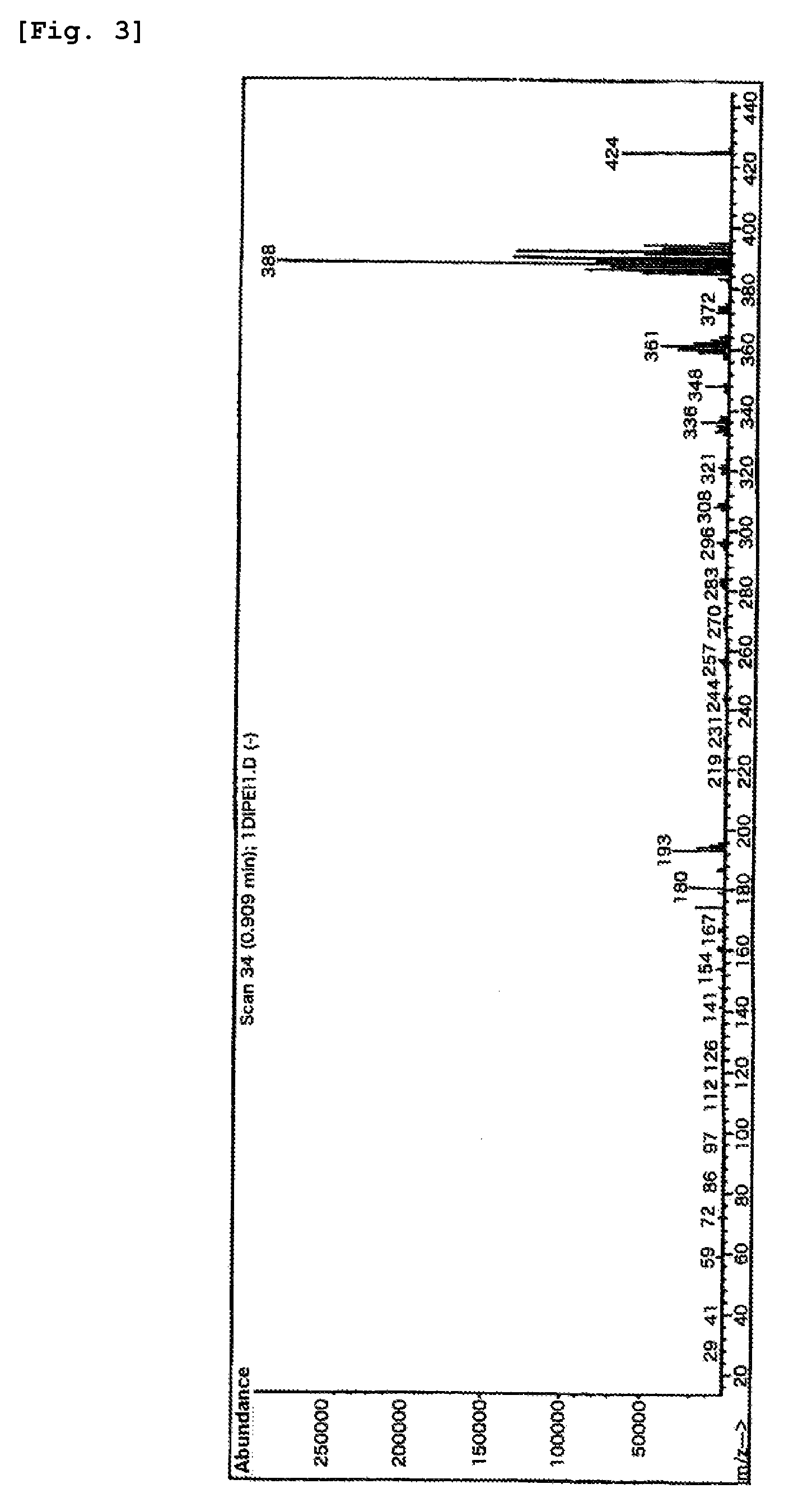Tantalum compound, method for producing same, tantalum-containing thin film and method for forming same
a technology of tantalum compound and thin film, applied in the field of tantalum compound and a method for producing the same, can solve the problems of degradation of the performance of the insulating film, delay of signal transmission, and generation of defects
- Summary
- Abstract
- Description
- Claims
- Application Information
AI Technical Summary
Benefits of technology
Problems solved by technology
Method used
Image
Examples
example 1
Synthesis of trihydridobis(propylcyclopentadienyl)tantalum (Ta(PrCp)2H3)
[0052]80.0 g (223 mmol) of tantalum pentachloride was suspended in 1,340 ml of ether, and 324 ml (220 mmol) of isopropyl magnesium bromide (0.68M THF solution) was added thereto. A solution of 50.2 g (440 mmol) of propylcyclopentadienyl lithium prepared from propylcylopentadiene and butyl lithium in THF (380 ml) was added, followed by refluxing for 1 hour. The solvent was distilled away, and the residue was dried at 80° C. in vacuo for 8 hours to obtain a brownish-red solid containing dichlorobis(propylcyclopentadienyl)tantalum (Ta (PrCp)2Cl2). 2,100 ml of toluene was added to this brownish-red solid, and the resulting mixture was ice-cooled. 198 ml (660 mmol) of a toluene solution (65 wt %) of sodium bis(2-methoxyethoxy)aluminum hydride was added dropwise to the mixture, and temperature was returned to room temperature, followed by stirring for 19.5 hours. 106 ml of water was added to the mixture, followed by s...
example 2
Synthesis of hydridobis(propylcyclopentadienyl)carbonyl-tantalum (Ta(PrCp)2(CO)H)
[0054]11.2 g (28.1 mmol) of trihydridobis(propyl-cyclopentadienyl)tantalum was heated to 135° C. in nonane (200 ml) under a carbon monoxide atmosphere, and stirred for 4 hours. The solvent was distilled away from the reaction mixture, and a solution hexane-extracted from the residue was concentrated to about 200 ml, and then cooled to −70° C. The supernatant was removed, and the solid was washed with 20 ml of hexane two times, and dried in vacuo to obtain 7.45 g (yield: 62.4%) of a purple solid. Thermal analysis result of the tantalum compound obtained is shown in FIG. 1. It is seen from this Figure that the tantalum compound obtained has a wide temperature range at which the compound can vaporize stably without decomposition, and thermally decomposes in the vicinity of 260° C., and the compound is therefore suitable as a raw material of a tantalum-containing thin film by CVD method or ALD method.
[0055]...
example 3
Synthesis (1) of bis(ethylcyclopentadienyl)trihydrido-tantalum (Ta(EtCp)2H3)
[0063]75.0 g (209 mmol) of tantalum pentachloride was suspended in 1,200 ml of ether, and 335 ml (228 mmol) of isopropyl magnesium bromide (0.68M THF solution) was added thereto. A solution of 41.9 g (419 mmol) of ethylcylopentadienyl lithium prepared from ethylcylopentadiene and butyl lithium in THF (240 ml) was added, followed by refluxing for 1 hour. The solvent was distilled away, and the residue was dried at 80° C. in vacuo for 8 hours to obtain a dark brown solid containing bis(ethylcyclopentadienyl)dichlorotantalum (Ta(EtCp)2Cl2). 1,060 ml of toluene was added to this dark brown solid, and the resulting mixture was ice-cooled. 187 ml (623 mmol) of a toluene solution (65 wt %) of sodium bis(2-methoxyethoxy)aluminum hydride was added dropwise to the mixture, and temperature was returned to room temperature, followed by stirring for 17 hours. 107 ml of water was added to the mixture, followed by stirring...
PUM
| Property | Measurement | Unit |
|---|---|---|
| melting point | aaaaa | aaaaa |
| temperature | aaaaa | aaaaa |
| boiling point | aaaaa | aaaaa |
Abstract
Description
Claims
Application Information
 Login to View More
Login to View More - R&D
- Intellectual Property
- Life Sciences
- Materials
- Tech Scout
- Unparalleled Data Quality
- Higher Quality Content
- 60% Fewer Hallucinations
Browse by: Latest US Patents, China's latest patents, Technical Efficacy Thesaurus, Application Domain, Technology Topic, Popular Technical Reports.
© 2025 PatSnap. All rights reserved.Legal|Privacy policy|Modern Slavery Act Transparency Statement|Sitemap|About US| Contact US: help@patsnap.com



